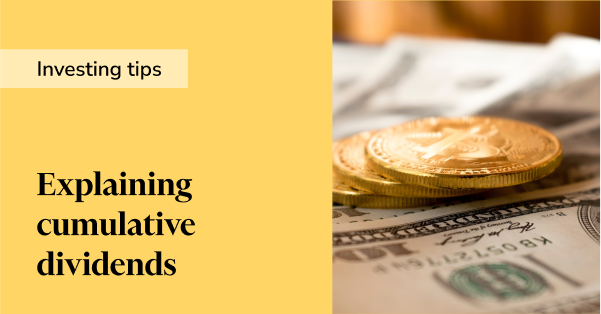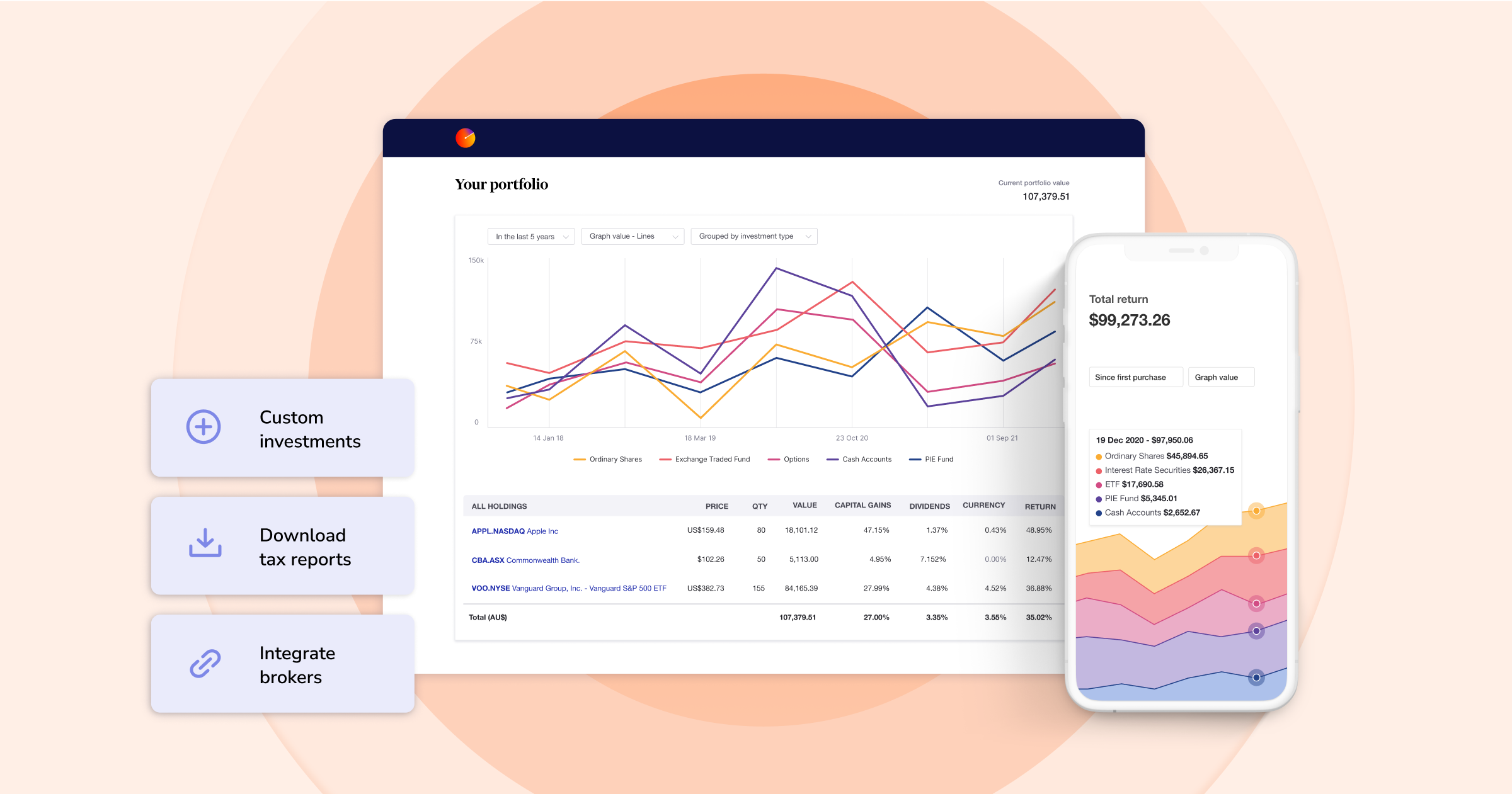What is a cumulative dividend?
If you’ve ever invested in preferred shares, you may have come across the term "cumulative dividend". This is a type of dividend eligible to some holders of preferred shares, which is paid under different conditions than a common dividend. To learn more about how cumulative dividends work, the pros and cons of receiving cumulative dividends and how to keep track of them using Sharesight, keep reading.

What is a cumulative dividend?
A cumulative dividend is a financial benefit attached to certain preferred shares. It guarantees investors that a certain fixed amount or percentage of the share’s par value will be paid out as a periodic dividend independent of company performance.
Unlike non-cumulative dividends, which the company can elect to halt at any time, cumulative dividends must be paid out to shareholders. This guarantees investors an extra degree of security in what might otherwise be a risky or less profitable investment.
How does a cumulative dividend work?
A cumulative dividend is essentially the mandatory interest that a company pays on its preferred shareholders’ capital. In return for financing the company, preferred shareholders are guaranteed set cumulative dividends which are paid to them periodically – even if the company isn’t operating at a profit.
Note that cumulative dividends are only attached to preferred shares (shares that have priority over common shares when dividends are being issued). Common shares generally have no right to cumulative dividends.
Because cumulative dividends are a binding obligation, a company must pay them out before distributing common dividends to the rest of their shareholders. If a company cannot afford to pay its cumulative dividends on time, it must halt payments to all shareholders while it sources the capital necessary to clear the debt. During that time, unpaid cumulative dividends must also be announced in financial statements.
How do you calculate cumulative dividends?
In order to calculate a stock’s cumulative dividend per share, there are a few simple steps.
First, you will need to determine the stock’s annual dividend payment using the following formula: Annual dividend = dividend rate x par value.
Note: The dividend rate is generally an agreed percentage of the share’s par value. In some cases, however, it may be a fixed amount. This depends on the specifics of the obligation. The par value is the face value of the share, which is the value of the share as listed in the corporate charter, rather than the market value.
Next, you can find the stock’s quarterly dividend payment by using the following formula: Quarterly dividend = annual dividend / 4.
After this, you will need to determine the number of quarterly preferred dividend payments the company has missed, which can be found in the company’s financial reports.
To calculate the cumulative dividend per share, simply multiply the number of missed quarterly preferred dividend payments by the quarterly dividend payment amount. In summation: Cumulative dividend per share = missed quarterly preferred dividend payments x quarterly dividend payment.
What are cumulative preferred shares?
If you want the benefits of cumulative dividends, you will need to invest in cumulative preferred shares first. This is a type of preferred share that guarantees the back-payment of withheld or halted dividends.
This differs from non-cumulative preferred shares, where shareholders have no right to claim dividends they missed out on in the past. If the company is in financial trouble or chooses to withhold dividends, shareholders simply have to go without.
As a cumulative preference shareholder, however, you effectively receive an IOU on any dividends that go unpaid. What’s more, the company must settle all cumulative dividends before they can pay their common shareholders.
Benefits of cumulative dividends
Guaranteed returns
Cumulative dividends are guaranteed regardless of company performance, meaning they could be a stable source of investment return in the long run.
Risk management
If you’re investing in a volatile market or financially unstable company, cumulative dividends will minimise your risk exposure. Even if it performs poorly, you will still see an investment return.
Priority access to common equity
Shareholders of cumulative preferred stocks have first access to common equity if the business is liquidated. That means you’ve got a higher chance of recouping your investment if the business becomes insolvent.
Disadvantages of cumulative dividends
Limited returns
The fixed nature of cumulative dividends means they don’t grow with business profitability. If the company reports increased earnings that result in bigger payouts for common shareholders, cumulative dividends remain the same.
Lower payment rate
Due to their reduced risk, cumulative dividends tend to pay less than non-cumulative dividends.
No voting rights
While cumulative preferred shares are technically classed as equity, their holders are treated more like creditors. Generally, they have limited or no voting rights in the business.
Example of cumulative dividends in action
Daybreak Systems, a computer hardware company, issues a cumulative preferred share with a par value of $100 and an annual dividend rate of 5% ($5 per share each year).
Rhiannon, an investor, purchases 100 of these shares – guaranteeing her a total of $500 in cumulative dividends each year regardless of company performance.
However, Daybreak experiences financial difficulties that year and opts to pay half of the dividend only. This means Rhiannon only receives $250, with the other $250 in arrears.
Things worsen in the year following, and Daybreak can no longer afford to pay the dividend at all. Rhiannon is now owed a total of $750 ($250 from the previous year, plus the full $500 dividend from this year).
Things turn around once Daybreak releases a new product a year later. With improved earnings, the company can now pay its cumulative preferred shareholders. Rhiannon receives:
-
The $750 in arrears from the previous two years
-
$500 for the current year
Once Daybreak clears its debts with all cumulative preferred shareholders, it can choose whether or not to issue dividends to its common shareholders.
Looking for an easy way to track your dividends?
When you have cumulative dividends owed, reinvested dividends to track, and years’ worth of financial data to compare, even the most careful spreadsheet starts to crack under pressure.
But there’s an easier way to track your dividends. Sharesight’s dividend tracking tool allows you to:
-
View all your dividends in one place
-
Track your dividend yields as they automatically adjust in real-time
-
Monitor the impact of your reinvested dividends
-
Automatically calculate franking credits and ATO tax entities
-
Import up to 20 years’ worth of prior dividends
Track your dividends (and performance) with Sharesight
Thousands of investors like you are already using Sharesight to manage their investment portfolios. What are you waiting for? Sign up and:
-
Track all of your investments in one place, including stocks, ETFs, mutual/managed funds, property and even cryptocurrency
-
Automatically track your dividend and distribution income from stocks, ETFs and mutual/managed funds
-
Run powerful reports built for investors, including Performance, Portfolio Diversity, Contribution Analysis, Future Income and Multi-Currency Valuation
-
See the true picture of your investment performance, including the impact of brokerage fees, dividends, and capital gains with Sharesight’s annualised performance calculation methodology
Sign up for a FREE Sharesight account and get started tracking your investment performance (and tax) today.

Disclaimer: The above article is for informational purposes only and does not constitute a product recommendation, or taxation or financial advice and should not be relied upon as such. Always check with your financial adviser or accountant to obtain the correct advice for your situation.
FURTHER READING

8 ways to use Sharesight's custom groups feature
This blog explains our custom groups feature, including strategies that can help you gain deeper portfolio insights and make more informed investing decisions.

You can time the market – and ETFs are the way to do it
Marcus Today founder and director Marcus Padley discusses timing the market, and how investors can do this using exchange-traded funds (ETFs).

Morningstar analyses Australian investors’ top trades: Q1 2025
Morningstar reviews the top 20 trades by Australian Sharesight users in Q1 2025, and reveals where their analysts see potential opportunities.